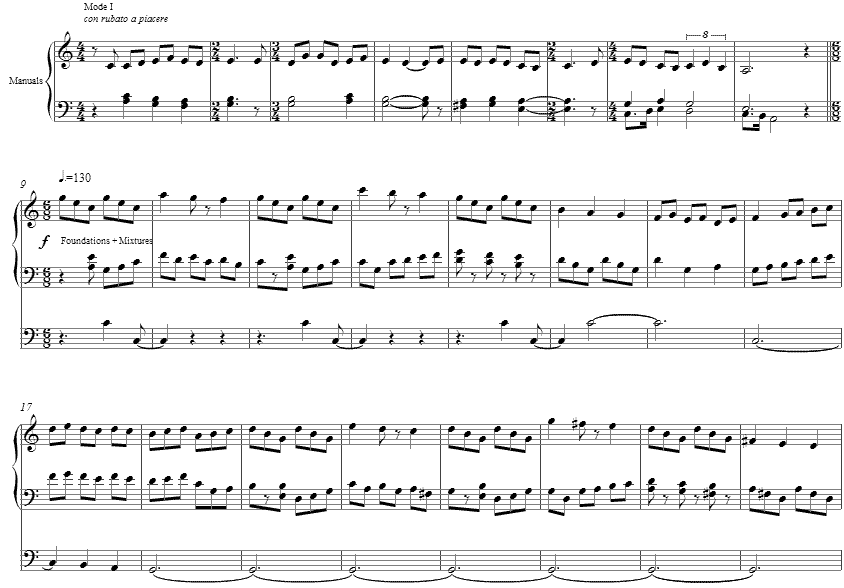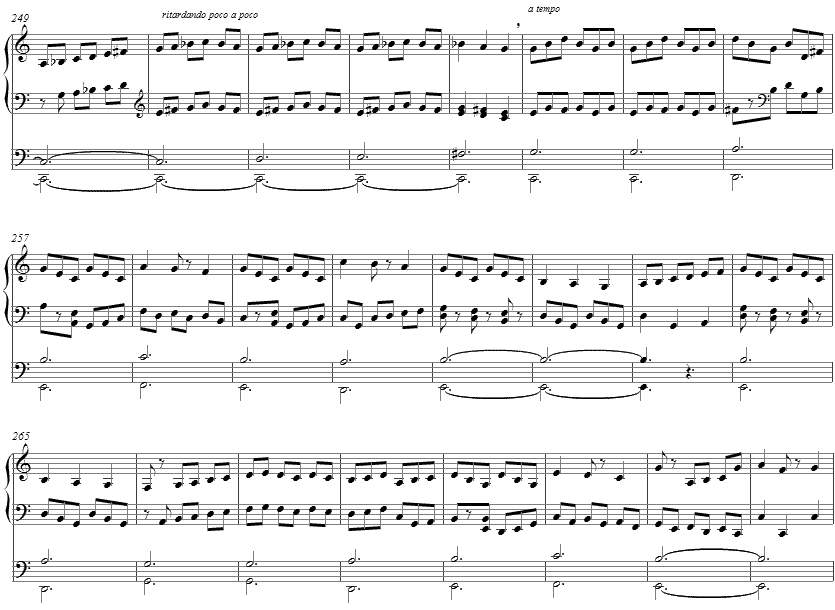Music and Texts of GARY BACHLUND
Vocal Music | Piano | Organ | Chamber Music | Orchestral | Articles and Commentary | Poems and Stories | Miscellany | FAQs
Fantasia on "Splendor paternae gloriae" - (2002)
for organ
"Splendor paternae gloriae" is a hymn for morning times asking for help and guidance throughout the day. Written by St. Ambrose, Bishop of
Milan (340-397), the hymn served as a companion hymn to his "Aeternae rerum Conditor." The hymn is traditionally sung at Monday Lauds and is used in the Liturgia Horarum at Lauds for Monday of the first and third weeks of the Psalter during Ordinary Time. The text in Latin and English translation reads:
Splendor paternae gloriae, de luce lucem proferens, lux lucis et fons luminis, diem dies illuminans.
Splendor of the Father's glory, that brings light from light, light of light and living spring, day of days illumining.Ambrose wrote hymns in a style severely elegant, chaste, clothing Christian theology in classical phraseology. In this way he appealed to popular tastes of the time and he is therefore credited with finding a new form, creating a new school of hymnody.
The melody for this hymn found in the Liber is in the Ionian mode, often thought of as bright and "sunny" by theoreticians since Guido d'Arezzo. Guido described a variety of organum (adding to a plainchant melody a second voice singing different pitches) that moved largely, but not completely, in parallel fourths. Guido's work is known through his treatise, the Micrologus. Given these historical facts, developing the theme suggested the use of parallelism.
A fantasia is most often defined as a composition "free in form and inspiration" and usually for an instrumental soloist. In 16th and 17th century England the term was applied especially to fugal compositions and other forms of melodic imitation for "consorts" -- groups of string or wind instruments. Earlier 16th-century fantasias for lute or keyboard consisted of short sections based on one or more musical motives. The contrapuntal organ fantasias of J. S. Bach were unlike the English fantasia, far more complex and of extended length, which inspired similar works by Franz Liszt, Max Reger, and Ferruccio Busoni.
After the opening statement of this theme drawn from the Liber in Mode I, the brilliant toccata-like texture of the fantasia begins, with a hemiola-like rhythm and continued restatements of the theme in the pedal. The entire theme of the hymn is not quoted, only the first four phrases are taken for this theme.
[ 14 pages, circa 6' 20" ]
Demo excerpt from beginning through measure 22, as noted above, and into first statement of the theme in the pedal.
[ MP3 file 956 KB, circa 60" ]
The restatement of the theme in the pedal is continued further on in parallel fifths, reminiscent of the tradition of organum, as mentioned above. As the theme suggests harmonic progression through the supertonic, the statement of the theme delivers the fantasia temporarily into D.
Demo excerpt from measure 107 above through to completion of the theme. [ MP3 file 410 KB, circa 26" ]
Several more restatements of the theme occur as the tonal domains broaden above it until measure 235. A relaxing of the harmonic tension returns then to the theme now in parallel at the twelfth.
Demo excerpt from measure 254 above through to the end -- four pages in the full score. [ MP3 file 1.63 MB, circa 1' 45" ]
The coda recalls the parallelism of organum through the complete parallel triadic harmony, and a final broad polytonal cadence. The toccata-like texture above and the long-lined Ambrosian plainsong theme in the pedal (cantus planus is the original 13th century term from which the term comes into theory's vocabulary) combine to make a virtuosic piece.
The entire work may be heard as well here,
[ MP3 file 5.93 MB, circa 6' 20" ].
The score for Fantasia on "Splendor paternae gloriae" is available as a free PDF download, though any major commercial performance or recording of the work is prohibited without prior arrangement with the composer. Click on the graphic below for this organ score.
Fantasia on "Splendor paternae gloriae"


